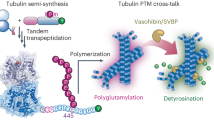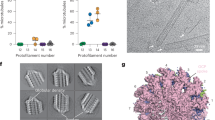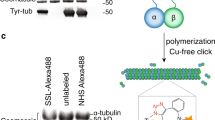Abstract
In vitro reconstitutions of microtubule assemblies have provided essential mechanistic insights into the molecular bases of microtubule dynamics and their interactions with associated proteins. The tubulin code has emerged as a regulatory mechanism for microtubule functions, which suggests that tubulin isotypes and post-translational modifications (PTMs) play important roles in controlling microtubule functions. To investigate the tubulin code mechanism, it is essential to analyze different tubulin variants in vitro. Until now, this has been difficult, as most reconstitution experiments have used heavily post-translationally modified tubulin purified from brain tissue. Therefore, we developed a protocol that allows purification of tubulin with controlled PTMs from limited sources through cycles of polymerization and depolymerization. Although alternative protocols using affinity purification of tubulin also yield very pure tubulin, our protocol has the unique advantage of selecting for fully functional tubulin, as non-polymerizable tubulin is excluded in the successive polymerization cycles. It thus provides a novel procedure for obtaining tubulin with controlled PTMs for in vitro reconstitution experiments. We describe specific procedures for tubulin purification from adherent cells, cells grown in suspension cultures and single mouse brains. The protocol can be combined with drug treatment, transfection of cells before tubulin purification or enzymatic treatment during the purification process. The amplification of cells and their growth in spinner bottles takes ~13 d; the tubulin purification takes 6–7 h. The tubulin can be used in total internal reflection fluorescence (TIRF)-microscopy-based experiments or pelleting assays for the investigation of intrinsic properties of microtubules and their interactions with associated proteins.
This is a preview of subscription content, access via your institution
Access options
Access Nature and 54 other Nature Portfolio journals
Get Nature+, our best-value online-access subscription
$29.99 / 30 days
cancel any time
Subscribe to this journal
Receive 12 print issues and online access
$259.00 per year
only $21.58 per issue
Buy this article
- Purchase on Springer Link
- Instant access to full article PDF
Prices may be subject to local taxes which are calculated during checkout




Similar content being viewed by others
Data availability
The data that support the findings of this study are available from the corresponding author upon reasonable request.
References
Borisy, G. G. & Taylor, E. W. The mechanism of action of colchicine. Binding of colchincine-3H to cellular protein. J. Cell Biol. 34, 525–533 (1967).
Weisenberg, R. C. Microtubule formation in vitro in solutions containing low calcium concentrations. Science 177, 1104–1105 (1972).
Borisy, G. G. & Olmsted, J. B. Nucleated assembly of microtubules in porcine brain extracts. Science 177, 1196–1197 (1972).
Kirschner, M. W. & Williams, R. C. The mechanism of microtubule assembly in vitro. J. Supramol. Struct. 2, 412–428 (1974).
Margolis, R. L. & Wilson, L. Addition of colchicine-tubulin complex to microtubule ends: the mechanism of substoichiometric colchicine poisoning. Proc. Natl. Acad. Sci. USA 74, 3466–3470 (1977).
Murphy, D. B. & Borisy, G. G. Association of high-molecular-weight proteins with microtubules and their role in microtubule assembly in vitro. Proc. Natl. Acad. Sci. USA 72, 2696–2700 (1975).
Margolis, R. L. & Wilson, L. Opposite end assembly and disassembly of microtubules at steady state in vitro. Cell 13, 1–8 (1978).
Mitchison, T. & Kirschner, M. Dynamic instability of microtubule growth. Nature 312, 237–242 (1984).
Axelrod, D. Cell-substrate contacts illuminated by total internal reflection fluorescence. J. Cell Biol. 89, 141–145 (1981).
Dogterom, M. & Surrey, T. Microtubule organization in vitro. Curr. Opin. Cell Biol. 25, 23–29 (2013).
Nedelec, F. J., Surrey, T., Maggs, A. C. & Leibler, S. Self-organization of microtubules and motors. Nature 389, 305–308 (1997).
Bieling, P., Telley, I. A. & Surrey, T. A minimal midzone protein module controls formation and length of antiparallel microtubule overlaps. Cell 142, 420–432 (2010).
Roostalu, J. et al. Directional switching of the kinesin Cin8 through motor coupling. Science 332, 94–99 (2011).
Hendricks, A. G., Goldman, Y. E. & Holzbaur, E. L. F. Reconstituting the motility of isolated intracellular cargoes. Methods Enzymol. 540, 249–262 (2014).
Schaedel, L. et al. Microtubules self-repair in response to mechanical stress. Nat. Mater. 14, 1156–1163 (2015).
Vallee, R. B. Reversible assembly purification of microtubules without assembly-promoting agents and further purification of tubulin, microtubule-associated proteins, and MAP fragments. Methods Enzymol. 134, 89–104 (1986).
Castoldi, M. & Popov, A. V. Purification of brain tubulin through two cycles of polymerization-depolymerization in a high-molarity buffer. Protein Expr. Purif. 32, 83–88 (2003).
Wloga, D., Joachimiak, E., Louka, P. & Gaertig, J. Posttranslational modifications of tubulin and cilia. Cold Spring Harb. Perspect. Biol. 9, a028159 (2017).
Janke, C. The tubulin code: molecular components, readout mechanisms, and functions. J. Cell Biol. 206, 461–472 (2014).
Barisic, M. et al. Microtubule detyrosination guides chromosomes during mitosis. Science 348, 799–803 (2015).
Nirschl, J. J., Magiera, M. M., Lazarus, J. E., Janke, C. & Holzbaur, E. L. F. Alpha-tubulin tyrosination and CLIP-170 phosphorylation regulate the initiation of dynein-driven transport in neurons. Cell Rep. 14, 2637–2652 (2016).
Guedes-Dias, P. et al. Kinesin-3 responds to local microtubule dynamics to target synaptic cargo delivery to the presynapse. Curr. Biol. 29, 268–282.e8 (2019).
Hiller, G. & Weber, K. Radioimmunoassay for tubulin: a quantitative comparison of the tubulin content of different established tissue culture cells and tissues. Cell 14, 795–804 (1978).
Bulinski, J. C. & Borisy, G. G. Self-assembly of microtubules in extracts of cultured HeLa cells and the identification of HeLa microtubule-associated proteins. Proc. Natl. Acad. Sci. USA 76, 293–297 (1979).
Farrell, K. W. Isolation of tubulin from nonneural sources. Methods Enzymol. 85(Pt B), 385–393 (1982).
Banerjee, A., Roach, M. C., Trcka, P. & Ludueña, R. F. Preparation of a monoclonal antibody specific for the class IV isotype of beta-tubulin. Purification and assembly of alpha beta II, alpha beta III, and alpha beta IV tubulin dimers from bovine brain. J. Biol. Chem. 267, 5625–5630 (1992).
Newton, C. N. et al. Intrinsically slow dynamic instability of HeLa cell microtubules in vitro. J. Biol. Chem. 277, 42456–42462 (2002).
Lacroix, B. & Janke, C. Generation of differentially polyglutamylated microtubules. Methods Mol. Biol. 777, 57–69 (2011).
Widlund, P. O. et al. One-step purification of assembly-competent tubulin from diverse eukaryotic sources. Mol. Biol. Cell 23, 4393–4401 (2012).
Howes, S. C. et al. Structural differences between yeast and mammalian microtubules revealed by cryo-EM. J. Cell Biol. 216, 2669–2677 (2017).
Pamula, M. C., Ti, S.-C. & Kapoor, T. M. The structured core of human beta tubulin confers isotype-specific polymerization properties. J. Cell Biol. 213, 425–433 (2016).
Vemu, A., Atherton, J., Spector, J. O., Moores, C. A. & Roll-Mecak, A. Tubulin isoform composition tunes microtubule dynamics. Mol. Biol. Cell 28, 3564–3572 (2017).
von Loeffelholz, O. et al. Nucleotide- and Mal3-dependent changes in fission yeast microtubules suggest a structural plasticity view of dynamics. Nat. Commun. 8, 2110 (2017).
Chaaban, S. et al. The structure and dynamics of C. elegans tubulin reveals the mechanistic basis of microtubule growth. Dev. Cell 47, 191–204.e8 (2018).
Alper, J. D., Decker, F., Agana, B. & Howard, J. The motility of axonemal dynein is regulated by the tubulin code. Biophys. J. 107, 2872–2880 (2014).
Minoura, I. et al. Overexpression, purification, and functional analysis of recombinant human tubulin dimer. FEBS Lett. 587, 3450–3455 (2013).
Vemu, A. et al. Structure and dynamics of single-isoform recombinant neuronal human tubulin. J. Biol. Chem. 291, 12907–12915 (2016).
Ti, S.-C., Alushin, G. M. & Kapoor, T. M. Human beta-tubulin isotypes can regulate microtubule protofilament number and stability. Dev. Cell 47, 175–190.e5 (2018).
Uchimura, S. et al. A flipped ion pair at the dynein-microtubule interface is critical for dynein motility and ATPase activation. J. Cell Biol. 208, 211–222 (2015).
Denoulet, P., Eddé, B. & Gros, F. Differential expression of several neurospecific beta-tubulin mRNAs in the mouse brain during development. Gene 50, 289–297 (1986).
Song, Y. et al. Transglutaminase and polyamination of tubulin: posttranslational modification for stabilizing axonal microtubules. Neuron 78, 109–123 (2013).
Belvindrah, R. et al. Mutation of the alpha-tubulin Tuba1a leads to straighter microtubules and perturbs neuronal migration. J. Cell Biol. 216, 2443–2461 (2017).
Breuss, M. et al. Mutations in the murine homologue of TUBB5 cause microcephaly by perturbing cell cycle progression and inducing p53 associated apoptosis. Development 143, 1126–33 (2016).
Latremoliere, A. et al. Neuronal-specific TUBB3 is not required for normal neuronal function but is essential for timely axon regeneration. Cell Rep. 24, 1865–1879.e9 (2018).
Magiera, M. M. et al. Excessive tubulin polyglutamylation causes neurodegeneration and perturbs neuronal transport. EMBO J. 37, e100440 (2018).
Morley, S. J. et al. Acetylated tubulin is essential for touch sensation in mice. eLife 5, e20813 (2016).
Kalebic, N. et al. Tubulin acetyltransferase alphaTAT1 destabilizes microtubules independently of its acetylation activity. Mol. Cell. Biol. 33, 1114–1123 (2013).
Maurer, S. P., Bieling, P., Cope, J., Hoenger, A. & Surrey, T. GTPγS microtubules mimic the growing microtubule end structure recognized by end-binding proteins (EBs). Proc. Natl. Acad. Sci. USA 108, 3988–3993 (2011).
Sandblad, L. et al. The Schizosaccharomyces pombe EB1 homolog Mal3p binds and stabilizes the microtubule lattice seam. Cell 127, 1415–1424 (2006).
Janke, C. et al. Tubulin polyglutamylase enzymes are members of the TTL domain protein family. Science 308, 1758–1762 (2005).
van Dijk, J. et al. A targeted multienzyme mechanism for selective microtubule polyglutamylation. Mol. Cell 26, 437–448 (2007).
Rogowski, K. et al. Evolutionary divergence of enzymatic mechanisms for posttranslational polyglycylation. Cell 137, 1076–1087 (2009).
Rogowski, K. et al. A family of protein-deglutamylating enzymes associated with neurodegeneration. Cell 143, 564–578 (2010).
Aillaud, C. et al. Vasohibins/SVBP are tubulin carboxypeptidases (TCPs) that regulate neuron differentiation. Science 358, 1448–1453 (2017).
Nieuwenhuis, J. et al. Vasohibins encode tubulin detyrosinating activity. Science 358, 1453–1456 (2017).
Akella, J. S. et al. MEC-17 is an alpha-tubulin acetyltransferase. Nature 467, 218–222 (2010).
Shida, T., Cueva, J. G., Xu, Z., Goodman, M. B. & Nachury, M. V. The major alpha-tubulin K40 acetyltransferase alphaTAT1 promotes rapid ciliogenesis and efficient mechanosensation. Proc. Natl. Acad. Sci. USA 107, 21517–21522 (2010).
Magiera, M. M. & Janke, C. in Methods in Cell Biology Vol. 115 (eds Correia, J. J. & Wilson, L.) 247–267 (Academic Press, Burlington, MA, 2013).
Hubbert, C. et al. HDAC6 is a microtubule-associated deacetylase. Nature 417, 455–458 (2002).
Matsuyama, A. et al. In vivo destabilization of dynamic microtubules by HDAC6-mediated deacetylation. EMBO J. 21, 6820–6831 (2002).
Acknowledgements
We thank all members of the Janke lab for help during the establishment of the protocol. We thank the animal facility of the Institut Curie for help with mouse breeding and care. This work received support under the ‘Investissementsd’Avenir’ program launched by the French government and implemented by the French National Research Agency (ANR; award nos. ANR-10-LBX-0038 and ANR-10-IDEX-0001-02 PSL). The work of C.J. was supported by the Institut Curie, the ANR (award no. ANR-12-BSV2-0007), the Institut National du Cancer (INCA; grant nos. 2013-1-PL BIO-02-ICR-1 and 2014-PL BIO-11-ICR-1), the Fondation pour la Recherche Medicale (FRM; grant no.DEQ20170336756), and the CEFIPRA research project 5703-1. M.M.M. was supported by an EMBO short-term fellowship (ASTF 148-2015) and by the FondationVaincre Alzheimer (grant no. FR-16055p). J.S. was supported by an FRM fellowship (no. SPF20120523942) and the EMBO (grant nos. ALTF 638-2010 and EMBO ASTF 445-2012). S.B. was supported by the FRM (grant no. FDT201805005465). J.A.S. was supported by the European Union’s Horizon 2020 research and innovation programme under a Marie Skłodowska-Curie grant agreement (no. 675737). The antibody 12G10, developed by J. Frankel and M. Nelson, was obtained from the Developmental Studies Hybridoma Bank, which was developed under the auspices of the NICHD and is maintained by the University of Iowa.
Author information
Authors and Affiliations
Contributions
J.S. and M.M.M. established the spinner cultures for various cell lines (with the help of G.L. and A.M.G.) and adapted the tubulin purification protocol to spinner-grown cells. S.B. and M.M.M. established the tubulin prep from adherent cells. S.B., M.M.M. and A.S.J. contributed to improving the protocol for the tubulin prep from large cell quantities. M.M.M. established the tubulin prep protocol from single mouse brains. M.M.M. and C.J. supervised the development of this method and wrote the manuscript. All the authors contributed to corrections of the text and figures.
Corresponding authors
Ethics declarations
Competing interests
The authors declare no competing interests.
Additional information
Journal peer review information: Nature Protocols thanks Manuel Théry and Maria Zanic for their contribution to the peer review of this work.
Publisher’s note: Springer Nature remains neutral with regard to jurisdictional claims in published maps and institutional affiliations.
Related links
Key references using this protocol
Barisic, M. et al. Science 348, 799–803 (2015): http://science.sciencemag.org/content/348/6236/799
Nirschl, J. J., Magiera, M. M., Lazarus, J. E., Janke, C. & Holzbaur, E. L. F. Cell Rep. 14, 2637–2652 (2016): https://www.cell.com/cell-reports/fulltext/S2211-1247(16)30167-X
Guedes-Dias P. et al. Curr. Biol. 29 268–282.e8 (2019): https://www.cell.com/current-biology/fulltext/S0960-9822(18)31595-1
Supplementary information
Rights and permissions
About this article
Cite this article
Souphron, J., Bodakuntla, S., Jijumon, A.S. et al. Purification of tubulin with controlled post-translational modifications by polymerization–depolymerization cycles. Nat Protoc 14, 1634–1660 (2019). https://doi.org/10.1038/s41596-019-0153-7
Received:
Accepted:
Published:
Issue Date:
DOI: https://doi.org/10.1038/s41596-019-0153-7
This article is cited by
-
Serotonin type-3 receptor antagonists selectively kill melanoma cells through classical apoptosis, microtubule depolymerisation, ERK activation, and NF-κB downregulation
Cell Biology and Toxicology (2023)
-
Lysate-based pipeline to characterize microtubule-associated proteins uncovers unique microtubule behaviours
Nature Cell Biology (2022)
-
Schizophrenia-associated dysbindin modulates axonal mitochondrial movement in cooperation with p150glued
Molecular Brain (2021)
-
The tubulin code and its role in controlling microtubule properties and functions
Nature Reviews Molecular Cell Biology (2020)
-
Direct observation of dynamic protein interactions involving human microtubules using solid-state NMR spectroscopy
Nature Communications (2020)
Comments
By submitting a comment you agree to abide by our Terms and Community Guidelines. If you find something abusive or that does not comply with our terms or guidelines please flag it as inappropriate.



